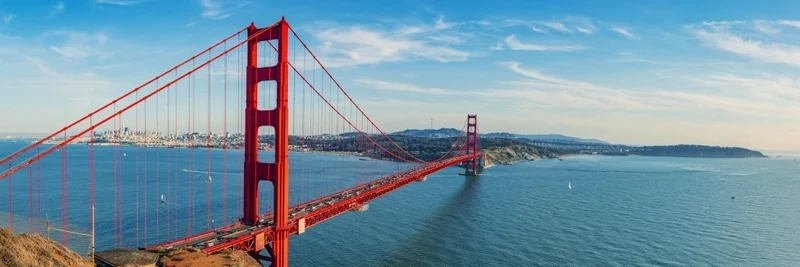Moving to San Francisco? Here’s what you need to know
Preparing for a move to San Francisco? In this guide, we introduce you to all the things you should know as you settle into the city from neighborhoods to keep an eye on to how to set up your finances after arrival
Nova Credit is a cross-border credit bureau that allows newcomers to apply for U.S. credit cards, phone plans, and loans using their foreign credit history.
Nova Credit receives compensation from third-party advertisers, but this content is not provided by them. Any opinions, analyses, reviews or recommendations expressed in this article are those of the authors alone, and have not been reviewed, approved or otherwise endorsed by any card issuer.

San Francisco is the “Paris of the West,” a famously foggy city full of art and culture with highly educated, innovative residents. The 15th-largest city in the U.S., it is small by the standards of American mega-cities. The land area is surrounded on three sides by water, and there are many hills and crooked streets. Less than one million people live in the city itself, with around another four million in its metropolitan area. The nine counties centered on San Francisco, including Silicon Valley, are referred to as “the Bay Area.” The area around the city of Oakland is known as “the East Bay.” San Francisco has traditionally been a gateway to the Pacific, and is home to many Asian immigrants with significant Chinese, Filipino, Vietnamese, Japanese and Korean populations. Around 15% of the population is Latino. The city’s Mexican heritage stretches back centuries; the U.S. acquired California from Mexico through a 1848 treaty.
How to find an apartment
San Francisco is now home to a thriving economy while it wrestles with a housing crisis. Census figures show that San Francisco has a high apartment vacancy rate. However, it is quite difficult to find an apartment. According to a study by the City’s planning department, 65% of households in San Francisco rent, compared to 45% in the Bay Area overall. Zumper, an apartment rental website, noted that San Francisco one-bedroom rent hit a record $3,720 in Summer 2019. Because the city is so congested, it is important to pick your neighborhood carefully.
Climate and age of the building are two factors you should consider. San Francisco has many micro-climates, and one study by HotPads, an apartment rental website, found that rental prices vary by the amount of fog in an area. Curbed San Francisco, a local news and real estate site, has published a guide to many city neighborhoods. Many apartments built in San Francisco before 1979 are covered by a Rent Ordinance. This set of laws stabilizes rents. It also offers tenant protections. Those older apartments, though, may have smaller windows and less modern heating than newer buildings.
When you’re looking for an apartment, check craigslist.org — the classified site was founded in San Francisco. Newspaper classifieds are good sources as well. Also check apartment rental sites such as Apartment List, as well as HotPads and Zumper. It’s important to ask your network too; 9% of renters found their current apartment through a tenant in the building.
When you’re looking at apartments, bring an employment letter with you. The letter should show your job title and your salary. If you landlord wants a guarantor, also known as a co-signer, you’ll want to tap someone local. In-state co-signers are often preferred. If you’re new in town, Nova Credit offers a partnership with The Guarantors. That financial company that will guarantee your rent payments for a fee.
In addition to rent, the landlord may ask for a security deposit, which must be refundable. The security deposit cannot be more than two months’ rent for an unfurnished unit or three months’ rent for a furnished one.
Alternatively, it may be possible to buy property if you meet certain residency, income and employment requirements.
How to get around
The San Francisco area transit card is known as the Clipper Card. A card costs $3 and works on the city transit system, which is nicknamed Muni, and on regional transit, nicknamed BART. (BART stands for Bay Area Rapid Transit.) BART stops running around midnight, while the Muni generally stops running at 1 a.m. The fare to ride a bus is $2.50, while the fare to ride one of San Francisco’s iconic cable cars is $8. If you are just visiting San Francisco temporarily, you can use services like Bounce for luggage storage in San Francisco.
Ask your employer if they offer transport to and from work. Since Silicon Valley is about 40 miles away from San Francisco, many firms run shuttle buses to take employees to their corporate campuses. (You may hear these shuttles referred to in San Francisco by the catch-all term “Google Bus.”)
The average commute in San Francisco is 32.8 minutes, but it’s a place where you’re lucky to be average. A shuttle from San Francisco to Facebook’s offices in Menlo Park, for example, takes about an hour and a half each way. Indeed, the share of “super-commuters” — commuters who take 90 minutes or more to get to work — is growing. Many of those super-commuters are going to or from San Francisco’s outskirts, but many of them are from San Francisco County. Average auto speeds during rush hour are dropping, and are now less than 15 miles an hour. It’s a congested city and can time to get around.
If you do want a car, the Department of Motor Vehicles issues driver’s licenses in San Francisco. You will have to prove that you are a resident of California but you do not need to be a U.S. citizen, or even be in the country legally, in order to get a California driver’s license. You will need to provide your Social Security number, take an eye test, and pass a knowledge test based on the California Driver Handbook.
How to set up your finances
To open a bank account, bring proof of residency. Possible proofs could be a cable bill or a copy of your lease. Also bring identification. A passport or a driver’s license will work. Many California banks will also accept a Matrícula Consular, a card issued by the Mexican government. Finally, bring your initial deposit.
Banks in San Francisco are immigrant-friendly. The “Bank On California” program, sponsored by the state government, helps immigrants open bank accounts. Both Bank of America and Wells Fargo are headquartered in San Francisco. A list of banks, including some popular bank branches, can be found here.
You’ll also want to transfer your credit history from your home country to help you rent an apartment, secure a post-paid cell plan, open a credit card or take out a loan. Nova Credit’s technology allows you to transfer your existing credit history from countries including Australia, India, Mexico and the UK. The company offers partnerships with leading financial companies to help you get started.
Over 100,000 recent newcomers trust Nova Credit
Subscribe to our newsletter for the latest tips and information on setting up life in the U.S.
How to find a job
The Bay Area has a massive economy. A report from the Bay Area Economic Council Economic Institute notes that, if the Bay Area were a country, it would have the 19th-largest economy in the world. That’s larger than the economy of Sweden or Saudi Arabia. “Silicon Valley” is home to world-famous companies in the technology/information sector. These giants include Google, Intel, Netflix and Oracle. It is also home to large energy companies such as Chevron and PG&E. There are large consumer products firms such as Apple, Clorox and The Gap. Large financial companies include Charles Schwab, Visa and Wells Fargo. A survey of the best-paying big companies found that eight out of the top ten were in the Bay Area.
In addition to high salaries, many tech companies give stock grants and provide generous benefits. In the San Francisco metropolitan area, average wages for “computer and mathematical occupations” (a job category that includes software engineers) are $120,730. Salaries for lawyers are the highest in the U.S., with San Jose paying an average $207,950 and San Francisco paying an average $183,070, according to U.S. News’ Best Jobs report.
The takeaway
For more resources on how to navigate your new life in the U.S., visit Nova Credit’s resource library where you can learn about everything related to the immigration process.
Use your foreign credit history to start your U.S credit history
New to the U.S.? Check if you can use your country's credit history in the U.S. to apply for credit cards and start your U.S credit history using Nova Credit.
More from Nova Credit:
The ultimate guide to the F-1 visa
The ultimate guide to the H-1B visa
The ultimate guide to the J-1 visa
The ultimate guide to the L-1 visa
The ultimate guide to the O-1 visa
How to check your USCIS case status
How to build credit after moving to the US
How to get a social security card
How to get an apartment with no credit history
No credit check cell phone plans
How to immigrate to the United States
